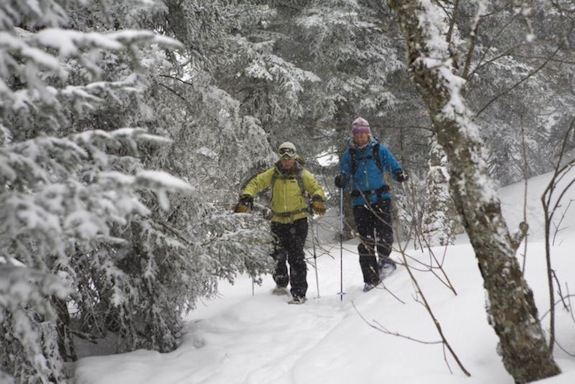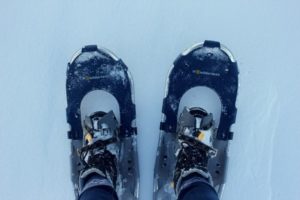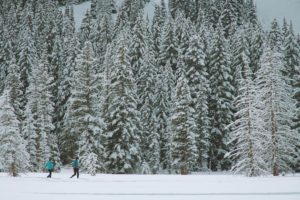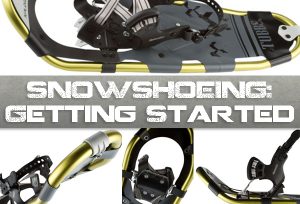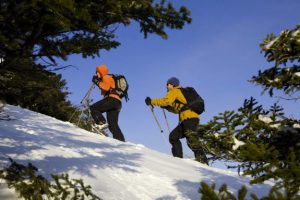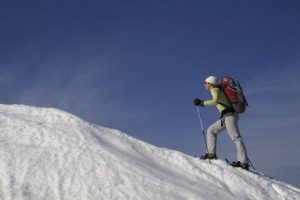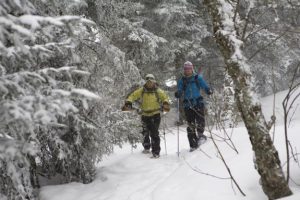
Choosing the Right Snowshoes
So, you’ve borrowed or rented some snowshoes, that likely weren’t a perfect fit, and now you’re ready to invest in your own set. Or maybe you’ve never even tried snowshoeing, but you know they’re a must for your winter gear closet. Regardless of your snowshoe intentions, the same benefits are achieved for every use – floatation and traction on snow are significantly improved and a healthy dose of safe, low impact exercise is achieved. With any gear purchase, it’s always a good idea to determine how often and where you plan to use the gear, your level of experience and how much you’re willing to spend. We’ve broken down all things to consider when buying a pair of snowshoes…
Snowshoe Construction
- Frame – The outer portion of a snowshoe is called the frame and is either constructed with aluminum, plastic or wood. An oblong or oval shape offers maximum floatation and is great for carrying heavy loads or for heavier people. A tapered tail track betters in the snow and allows you to walk with a more natural stride. Women’s specific snowshoes are almost always tapered, since women walk with their feet closer together. A tapered tail lessens the chance of the snowshoes clanking.
- Decking – Decking is the material that is stretched inside the frame allowing for a larger footprint in the snow. It’s typically made of synthetic rubber, plastic or Hyplon™, a lightweight and tough material.
- Bindings – Your boots are secured to the snowshoes with bindings, which maintain the alignment of your feet for efficient tracking. A good fitting binding is essential to achieve a natural stride. Women should always wear women’s specific snowshoes/bindings since their feet are narrower than men’s. Extra play in the binding could make for sore legs, a shorter day and possible injury. Either a rotating or fixed toe cord attaches to the binding. A rotating toe cord pivots under the balls of your feet allowing for the snow to shed from the tail with each step. Rotating or floating bindings are perfect for accurate steering in deep snow, but they can be awkward for scrambling over obstacles or backing up. A fixed toe cord doesn’t pivot as much and brings the snowshoe up with each step, making for a more natural stride from the start.
- Crampons and Traction Devices – For greater grip in the snow, snowshoes feature tooth-like crampons or cleats under the ball of the foot. They bite with every step and enhance footing for climbing, traversing and walking on icy terrain like a frozen pond. Advanced snowshoes have more aggressive cleats and sometimes even have cleats under the heel.
- Heel Lifts – When faced with steep uphill sections or a long ascent, a metal bar that lays flat under your boot heel can be lifted to reduce calf and Achilles tendon strain. Some snowshoes feature heel lifts as a standard feature or it can be added on.
Snowshoe Terrain
- Flat Terrain – Ideal for families, flat terrain may also consist of rolling hills. Look for high value entry level snowshoes with easy to adjust bindings and less aggressive traction.
- Rolling Terrain – For the intermediate to advanced snowshoer, rolling or steep terrain makes for beautiful winter hikes off the beaten track. You’ll need snowshoes with more aggressive traction and beefier bindings.
- Mountain Terrain – Icy, steep terrain without marked trails makes up mountain terrain. Overnight backpackers, snowboarders and all day hikers are attracted to this burly terrain. Snowshoes to make the trek possible have climbing-style crampons and extremely durable bindings that can withstand harsh conditions and aggressive use.
Snow Condtions
Of course conditions vary, but try to base your purchase off of where you will do the majority of your snowshoeing. If you live in Utah with light, fluffy powder, you’ll need shoes with a greater surface area. Increasing your size can achieve maximum float for such conditions. For Northeast snowshoeing, chances are you’ll be trekking up and down steeper terrain with tight turns and snow ranging from wet/packed to light as clouds. An oblong, compact shape with moderate to aggressive cleats is ideal. For wet snow conditions, typical of the Northwest, a compact shape will also be ideal since you won’t need as much float as wide open spaces with fresh powder.
Snowshoe Sizing
Weight is the main determinant for sizing your snowshoes. The more you weigh, the greater the surface are needs to be in order to gain floatation on the snow. If you’re over the weight limit, you’ll sink right to the bottom and will likely become very discouraged! Sizing generally runs between 20-36 inches and the width is designed to be proportional to the length. All snowshoes sold by The House show and accurate size chart, so you can’t go wrong! Remember to consider your total weight with expected gear in your pack. You don’t want to be caught in the backcountry well over the weight limit of your snowshoes!
If you are a gal, stick to the women’s specific snowshoes. They are engineered with a narrower frame and tail for an ideal fit and ease in finding your natural stride. Same goes for youth – do your kids a favor and be sure to style them out with youth specific snowshoes! They should get at least three years out of the same pair since the weight range is so broad!
Snowshoeing for Life
Snowshoes are an economical investment. Although technology does change every year, your shoes should last several seasons and beyond. Having your own pair will increases your chances of getting out for some winter hikes more often! Enjoy!
